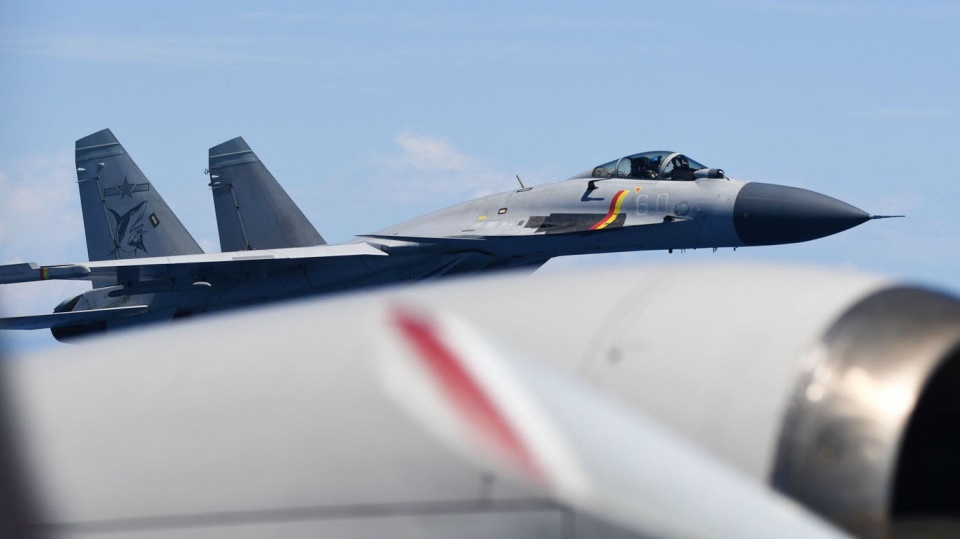Japan has formally protested to China following a series of dangerously close encounters between Chinese fighter jets and Japanese maritime patrol planes over the Pacific Ocean.
Online media sources say the confrontations occurred in an area where, for the first time, both of China’s active aircraft carriers were observed operating simultaneously.
According to Japan’s Kyodo news agency, the incidents involved a Chinese J-15 fighter jet that flew as close as 45 meters (approximately 147 feet) to a Japanese P-3C maritime surveillance aircraft.
These events, which took place last Saturday and Sunday, were described by Japanese officials as “dangerous maneuvers” and “near-miss” encounters.
Japan’s Chief Cabinet Secretary Yoshimasa Hayashi addressed the issue publicly, saying, “We have conveyed serious concerns to the Chinese side and have strongly urged them to prevent such incidents from occurring again.”
He emphasized that Japan would continue to monitor the airspace near its territory and maintain dialogue with China at multiple levels.
The P-3C aircraft involved in the incidents are part of Japan’s Maritime Self-Defense Force and are stationed on Okinawa Island.
They were conducting surveillance missions over international waters in the western Pacific when they encountered the Chinese military jets.
On Saturday, a J-15 launched from the Chinese aircraft carrier Shandong reportedly pursued a Japanese P-3C for around 40 minutes.
The following day, a similar situation unfolded, with another J-15 fighter tailing a Japanese aircraft for approximately 80 minutes.
During Sunday’s incident, the Chinese jet crossed directly in front of the Japanese plane at a distance of just 900 meters (about 2,950 feet), according to Japan’s defense ministry.
In a formal statement issued on Wednesday, the ministry warned that such reckless approaches by Chinese military aircraft pose a serious risk of unintended mid-air collisions.
The statement included photographs taken by Japanese crew members showing close-up views of the J-15 jet involved in Sunday’s encounter.
Fortunately, no damage to the Japanese aircraft or injuries to crew members were reported.
The recent confrontations mark the first such high-risk aerial interactions between Chinese and Japanese military aircraft in over a decade.
The last comparable incidents occurred in May and June of 2014, when Chinese Su-27 fighter jets flew within 30 meters (roughly 98 feet) of Japanese reconnaissance planes.
This prompted a similar outcry from Tokyo at the time.
The backdrop to these incidents is especially significant.
Over the same weekend, both of China’s operational aircraft carriers, the Shandong and the Liaoning, were detected operating in Japan’s vicinity, including inside its exclusive economic zone (EEZ).
This marked the first known occasion when the two vessels were deployed at the same time in the region, raising regional security concerns.
Kyodo reported that the Shandong conducted flight operations, including takeoffs and landings of aircraft, on Monday in waters north of Okinotori Island, Japan’s southernmost outpost, located within Japan’s EEZ.
Meanwhile, the Liaoning was also spotted on Saturday inside the EEZ before repositioning outside the zone.
There, it too carried out similar carrier-based flight drills on Sunday.
The presence of both Chinese carriers and their operational activities so close to Japanese territory, particularly within the EEZ, underscores rising tensions between the two countries.
While international law permits freedom of navigation in EEZs, Japan views such close military actions with increasing concern, particularly when paired with aggressive aerial maneuvers.
Chief Cabinet Secretary Hayashi reiterated that Japan will continue to monitor such developments vigilantly and maintain readiness to respond diplomatically and operationally.
“We will ensure continued surveillance of our surrounding airspace and keep lines of communication open with China to avoid any escalation,” he said.
Observers say that as China expands its naval and aerial reach, incidents such as these may become more frequent.
These may prompt calls for clearer protocols and risk reduction measures between regional powers to avoid unintended military confrontations.



